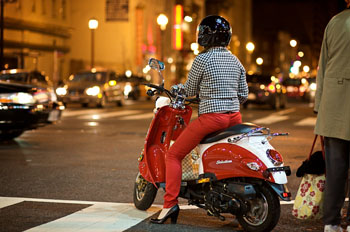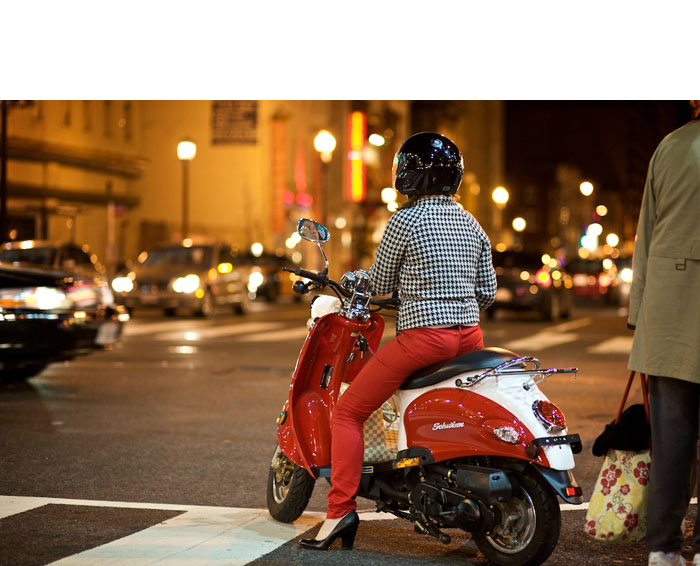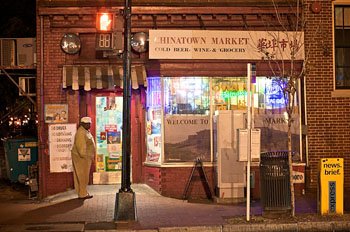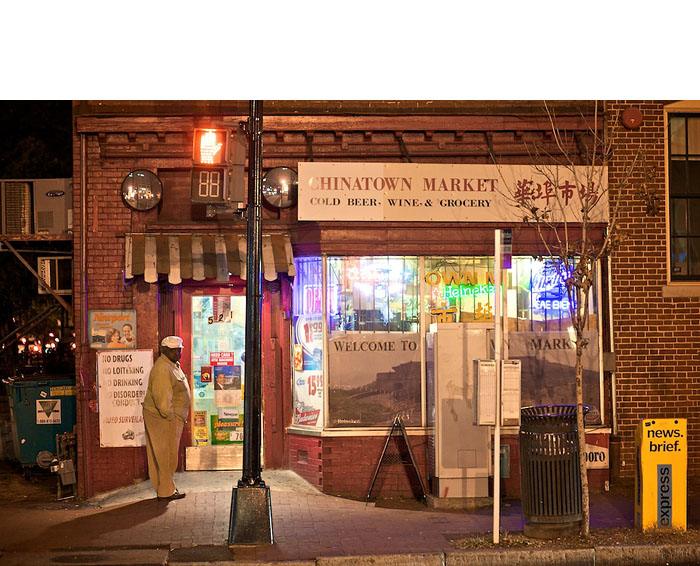While I was in Washington DC, teaching at the Photoshop LIVE conference, the good folks over at We Love DC put together an evening photowalk. And they were kind enough to invite me. We had a great time. So, as you've read in earlier posts, when I go street shooting, I often decide which rig I want to use, then try stick with it the entire time. This outing, I went with the Canon 5D Mark II and my trusty 85mm f/1.8 lens.
An interesting side note about the 85mm f/1.8. One of the photowalk participants noted my glass, then he said with a smile: "As yes, the 85mm f/1.8 -- my favorite lens that I rarely use." If you fall into this category, then I say break it out of storage and get to shooting with it. It's been around for a while, but it's a beautiful lens.
I began the evening while there was still some light in the sky, so I set the ISO to 800. As it became darker, I moved to ISO 1600 and even shot a few frames at 3200. Most of the time, I was in Aperture Priority mode, locking the camera in at f/1.8 and letting it figure out the best shutter speed. I overexpose by a half stop in these conditions, just to keep the blacks from plugging up too much. Another trick to help corral those wild tonal extremes is to shoot in Raw, then process in Aperture. (People keep asking me if I still use Aperture. Well, yes! All of my Canon Raw files are processed with it. By the same token, I use Lightroom and ACR for the Olympus E-P1. I'm just trying to use the best tool for the job at hand.)
I did pack a monopod, but as is often the case, I never pulled it out of my Lowepro Fastpack 250. I love monopods, but they sometimes slow me down while street shooting. So I usually opt for bracing myself against a wall or a poll during capture instead of mounting the camera on a stabilizing device. Plus, I think it's important to experiment with a variety of shooting angles, and I can become trapped into shooting everything at the same level with a monopod.
Photos by Derrick Story. Captured with a Canon 5D Mark II and an 85mm f/1.8 lens. Click on picture to zoom to larger size. More images from this collection are available at the Digital Story Flickr page.
For example, the shot of the red scooter was taking shape about 50 yards away. So I had to sprint into position, then get down low on one knee to frame the shot the way I wanted. I probably would have missed it all together with a monopod. And I hate missing shots!
You can see larger versions of these images, plus more frames from this shoot by visiting the Washington DC set on The Digital Story Flickr page. The last seven shots in that set are with the 5D Mark II, and the first five, recorded earlier that day in a different part of town, were with the Olympus E-P1.
And thanks to all the DC folks for their great hospitality during my visit! It's quite a friendly town for such a big city.
-
















Interesting selection of the 85mm for a street shooting lens, but the results speak for themselves. Most people would have grabbed a 35mm or 50mm. Would you have used the 85mm with a crop sensor body or gone with something wider?
Is using RAW mode a major requirement? I used similar settings in the photo below, and Aperture Priority set the shutter speed so low that I had to use a tripod. I'd appreciate suggestions on how to shoot my new outdoor lighting.
http://www.twitpic.com/fsjnu
Ferd, you actually have two separate issues.
The first, Raw, is important in night shooting, especially if you want to work with your image afterwards to fine tune it. I used Aperture on these images to pull a little more detail out of the shadows and highlights, but Lightroom or Adobe Camera Raw works fantastic too. Raw files contain more information than Jpegs to enable this.
The second issue has to do with the speed of your lens and the ISO setting. I was shooting at f/1.8, which lets a lot of light in through the lens to the camera sensor. I also had the ISO set to 800 or 1600, which makes the sensor more sensitive to light. This combination allowed me to shoot without a tripod.
I hope this helps a bit Ferd :)
I was on the walk with you and it fun watching a master at work! :-) Also, I was the only on the walk with a tripod... I shot almost all of my shot bracketed to create HDRs and a few came out pretty good, I think. I was shooting with my Tamron 90mm on a Canon 30D, so there were times when I would have like to have had a wider angle lens...
One thing I learned was why my pics were orange... I had played around with the different white balance settings and it difficult for me to figure out which one was the right one. When I got home I researched it and found it was the tungsten light setting I needed and was able to apply it my RAW files.
I was on the walk with you and it fun watching a master at work! :-) Also, I was the only on the walk with a tripod... I shot almost all of my shot bracketed to create HDRs and a few came out pretty good, I think. I was shooting with my Tamron 90mm on a Canon 30D, so there were times when I would have like to have had a wider angle lens...
One thing I learned was why my pics were orange... I had played around with the different white balance settings and it difficult for me to figure out which one was the right one. When I got home I researched it and found it was the tungsten light setting I needed and was able to apply it my RAW files.
I was on the walk with you and it fun watching a master at work! :-) Also, I was the only on the walk with a tripod... I shot almost all of my shot bracketed to create HDRs and a few came out pretty good, I think. I was shooting with my Tamron 90mm on a Canon 30D, so there were times when I would have like to have had a wider angle lens...
One thing I learned was why my pics were orange... I had played around with the different white balance settings and it difficult for me to figure out which one was the right one. When I got home I researched it and found it was the tungsten light setting I needed and was able to apply it my RAW files.
I was on the walk with you and it fun watching a master at work! :-) Also, I was the only on the walk with a tripod... I shot almost all of my shot bracketed to create HDRs and a few came out pretty good, I think. I was shooting with my Tamron 90mm on a Canon 30D, so there were times when I would have like to have had a wider angle lens...
One thing I learned was why my pics were orange... I had played around with the different white balance settings and it difficult for me to figure out which one was the right one. When I got home I researched it and found it was the tungsten light setting I needed and was able to apply it my RAW files.
Ah, I understand now. My lens is simply too slow. I don't mind using a tripod for what I'm doing. I took some RAW shots tonight and played with them a little. Most of the editor settings are familiar, such as Temperature.